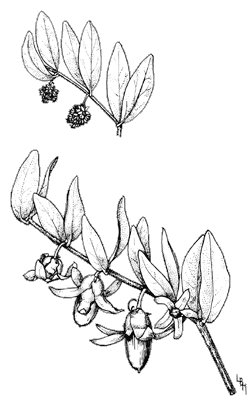Simmondsiaceae (jojoba family)
Simmondsia chinensis
English names: jojoba, goat nut, deer nut, pignut, wild hazel, quinine nut, coffeeberry, gray box bush
Spanish name: jojoba
Jojoba is currently the Sonoran Desert’s second most economically valuable native plant, overshadowed only by the Washington palms used in ornamental horticulture. Most people have at least heard of it though they may not know its proper pronunciation (hoe-HOE-buh).
Description
This is a woody, evergreen shrub, averaging 2 to 5 feet (0.6-1.5 m) tall and wide, sometimes to 10 feet (3 m), with leathery, grayish-green leaves. The pale green female flowers of this dioecious species are borne singly at each leaf node. The yellowish-green male flowers are borne in clusters. Plants bloom in winter and female plants ripen their acorn-shaped and -sized seeds in summer.
Range
Jojoba occurs throughout the Sonoran Desert where annual average rainfall exceeds 5 inches (125 mm). It extends beyond the desert into the coastal mountain ranges of southern California.
 |
Notes
The O’odham, who named the plant “jojoba,”use a paste of the nut as an antioxidant salve on burns. It was taken back to Spain and the Vatican as early as 1716 as a cure for baldness. (There is no evidence that it is effective in this regard.)
This is the sole species in the family Simmondsiaceae; it is sometimes placed in the box family, Buxaceae. Plants produce flower buds on the new summer growth. The plants must experience a certain number of chilling hours, after which the buds will mature and open in response to a late winter rain.
Though the flowers are wind-pollinated, the process is not completely passive. As breezes pass through the plants the leaves create vortexes. Pollen grains spiral around the female flowers hanging beneath the leaves and thus have several opportunities to contact the stigmas. An average-size bush produces more than 2 pounds (a kilogram) of pollen. The ratio of male to female plants is 4 to 1 in Arizona. Fortunately, few people are allergic to the pollen.
Though it’s usually an evergreen, jojoba will shed its leaves during severe droughts. The vertical orientation of jojoba leaves is an adaptation to the extreme desert heat. During midday in summer, when high leaf temperatures make photosynthesis less efficient, the sun is shining on the edges of the leaves. In morning and late afternoon, light reaches the flat leaf surfaces more directly, at a time when temperatures are more favorable for energy capture.
Jojoba “beans” contain more than 40 percent “oil,” which chemically is actually a liquid wax. The wax is highly resistant to oxidation (going rancid) and is stable at high temperatures. These properties make it a very high quality lubricant, equal to sperm whale oil. Only sperm whale or jojoba oil is acceptable for some industrial applications. The wax is also used in cosmetics. For these reasons and because sperm whales are endangered, jojoba is being developed as a commercial crop in several countries. Selective breeding is developing plants that produce more beans with higher wax content, as well as other characteristics that will facilitate harvesting.
The foliage provides year-round browse for many animals, especially deer, javelina, bighorn sheep, and livestock. Nuts are eaten by many animals, including squirrels and other rodents, rabbits and larger birds. However, only Bailey’s pocket mouse is known to be able to digest the wax. In large quantities, the seed meal is toxic to many mammals, and the indigestible wax acts as a laxative in humans. The Seri, who utilize nearly every edible plant in their territory, don’t regard the beans as real food and in the past ate it only in emergencies.